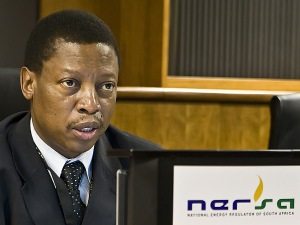
[miningmx.com] – BELT-tightening at Eskom in an effort to mitigate a R225bn revenue shortfall between 2013 and 2018 has been extended to the power utility’s senior executives who are to cede their annual bonuses.
Collin Matjila, Eskom’s interim CEO, said the decision was acknowledgement of the financial constraints under which the company laboured. The revenue shortfall relates to lower-than-hoped-for increases in the electricity tariff over the five-year period.
Eskom had in 2012 applied for 16% per year increase in the tariff over the five years, but was awarded half of that increase as industry, especially the mining companies, said runaway electricity costs could put them out of business.
Commenting in a statement today on the bonus sacrifice, Matjila said: “The board welcomed this move as the company is implementing efficiency intervention initiatives to achieve long-term financial sustainability’. He warned, however, that cost-cutting alone would not bridge the revenue span.
“While significant shifts have been made in terms of business operations to achieve internal efficiencies, the company is certain that this revenue shortfall cannot be achieved by belt tightening alone,” said Matjila.
“It remains important to move towards a cost-reflective tariff urgently. Eskom, through its shareholder ministry, the Department of Public Enterprises, is in discussion with the National Treasury to find a long-term solution,’ he said.
Following the lower-than-expected tariff, Eskom established a ‘business productivity programme’ (BPP) in 2013 to extract efficiencies within the business. The company is also studying a range of “non-conventional sustainable funding solutions”, said Matjila, “… including equity/equity-like instruments”.
Zola Tsotsi, chairman of Eskom, told Miningmx on May 29 that the firm was looking at potentially selling or joint venturing certain of its assets in the generation fleet. “We are looking within the generation stable [as to] what is possible,’ he said.
“We don’t have a difficulty if we can have the kind of joint venture partnership with outsiders who buy a stake or equity into our operations.”
“It will be a part equity solution in that we would offer an existing operation to someone who would like to invest because we believe there is merit in looking at some of the assets from that perspective,” said Zola.
“We would not have the entire generation fleet up for equity acquisition. We would not do that,” he said.
“In other words, we would not ring-fence the generation business and say: look is there any equity participant who would like to come in with us on the generation side; rather, it would be on a project-by-project basis on specific units and specific plants.”











